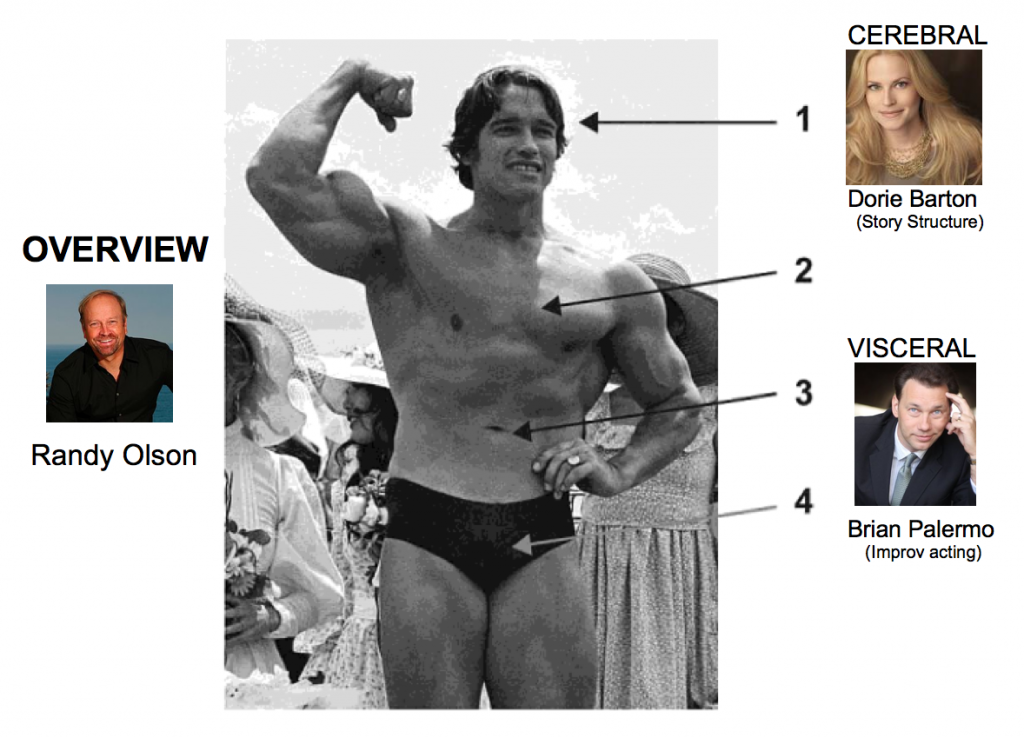#220) THE “S” TEAM COMMUNICATION WORKSHOP: The Basic Concept
July 2nd, 2012
For the past year we’ve been developing “The S Factor Team” where we break down my basic approach to storytelling (as the central element to broad communication) into the “cerebral” (with screenwriter/script analyst/actress Dorie Barton) and the “visceral” (with improv instructor/actor Brian Palermo). 
BREAKING DOWN “THE “S” TEAM.” For our workshops with science, public health, and environmental folks, I provide the overview of the cerebral vs. visceral elements of broad communication, much of which can be found in my book, “Don’t Be Such a Scientist.” I’m also somewhat of an “interpreter” for the more analytical folks being “bilingual” from having formerly been a tenured professor of biology then spent 20 years living in Hollywood attending film school, acting school and making films. Then I bring in two professionals (and long time friends) from Hollywood. Dorie gets deeper into the more cerebral elements of story structure using the foundations of narrative, based on her work in script development, while Brian brings in the energy of his career as a Groundling in Hollywood using improv acting techniques to come down out of your head and find the power of the more visceral forces. As actors they have both appeared in major films including, “Legally Blonde,” “Meet the Fockers,” “The Social Network,” and “Thank You for Smoking.” They are a real treat to work with.
scooby
COMMUNICATING THE WAY THE NOBEL LAUREATE TOLD US TO
A couple of weeks ago, I made some hay out of how Economics Nobel Laureate Daniel Kahneman told all the heavily cerebral types at the National Academy of Sciences‘ conference on “The Science of Science Communication,” that without creating a voice that is both likeable and trusted, all their evidence will never mean much. Likeability and trust are largely visceral forces. I found it to be a stunning message from one so cerebrally advanced, it’s also the core of my book and the workshops I run.
Over the past couple years I’ve gone further with this cerebral/visceral divide by assembling a team with a voice for each of the two elements. We began by doing workshops with the American Geophysical Union called “The S Factor”, so I figured we might as well use the same “S” name for the team.
I began assembling the team last year with an all-day workshop in Los Angeles for 25 environmentalists. I’ve known Dorie Barton for about a decade — first as an actress, then as script analyst for a friend’s company where she quickly became their most trusted voice for whether a script “worked” and if not, how to fix it. Brian Palermo I met through the Groudlings Improv Comedy Theater, cast him in a short film, then realized at the LA workshop he’s a tremendous improv instructor with the kind of energy that makes a workshop catch fire.
In February of this year we did our “S Factor” thing at the Ocean Sciences meeting. Next month we’ll be doing another all day workshop in San Francisco, this time with one of the largest environmental groups in the country.
At the core of the workshop is one concept — storytelling. The thing about storytelling is nobody’s perfect at it, it takes a long time to get both the cerebral (story structure) and visceral (character development) sides of it, and even the most successful storytellers in Hollywood still produce the occasional stinker that makes you wonder whether they really know much of anything at all (I remember when I first moved to Hollywood in 1994 hearing the industry buzz on Rob Reiner that, “he’s never had a flop,” then a friend took me with her to the premiere of “North” and there was Mr. Reiner walking around looking depressed — it has 11% on Rotten Tomatoes, stinky poo-poo!).
The best thing about storytelling is that when it works, it works so powerfully. As I was saying last week about the Aspen Environment Forum. It’s at the core of almost all effective communication, which is why it’s at the core or our workshops.